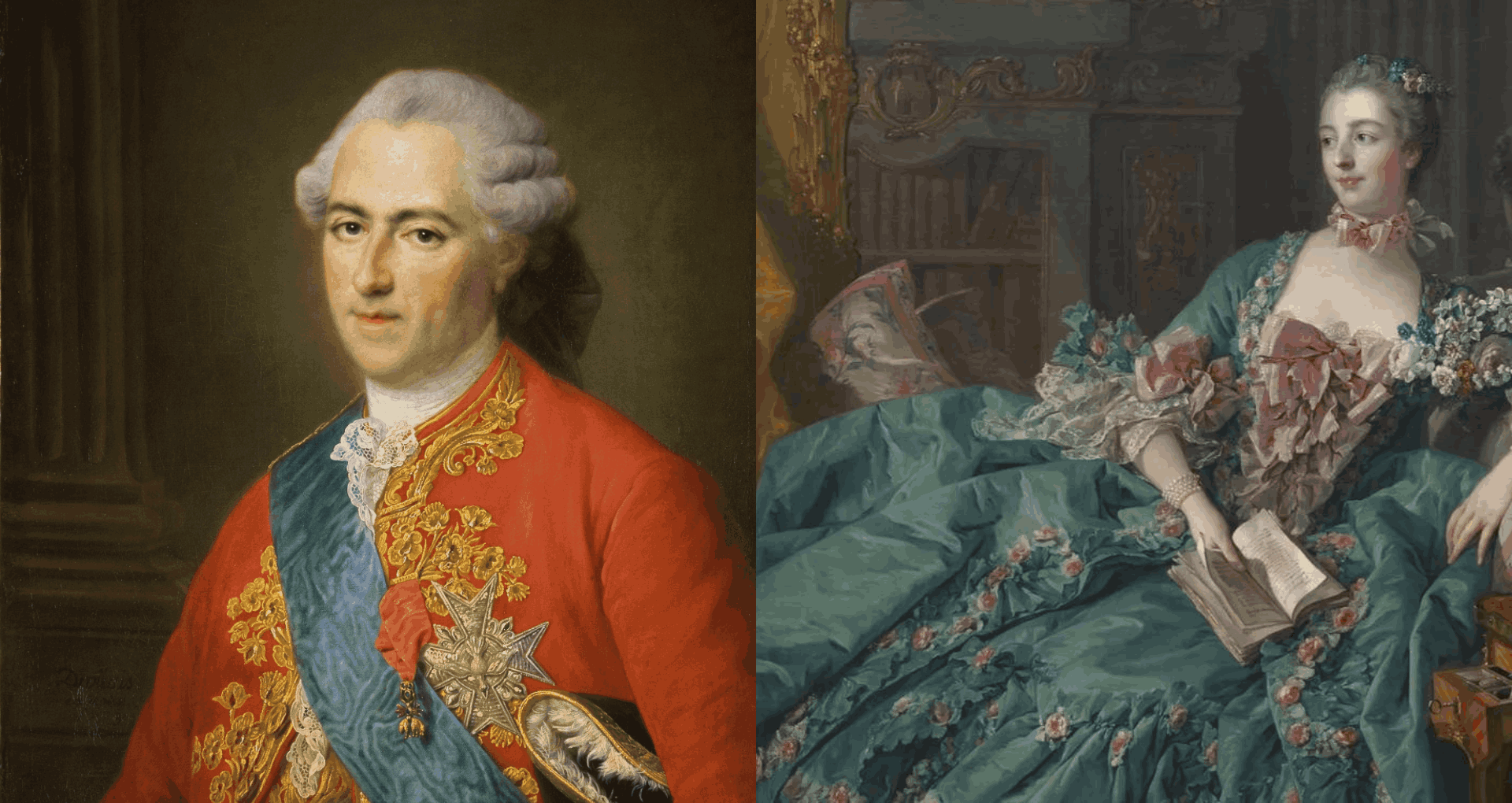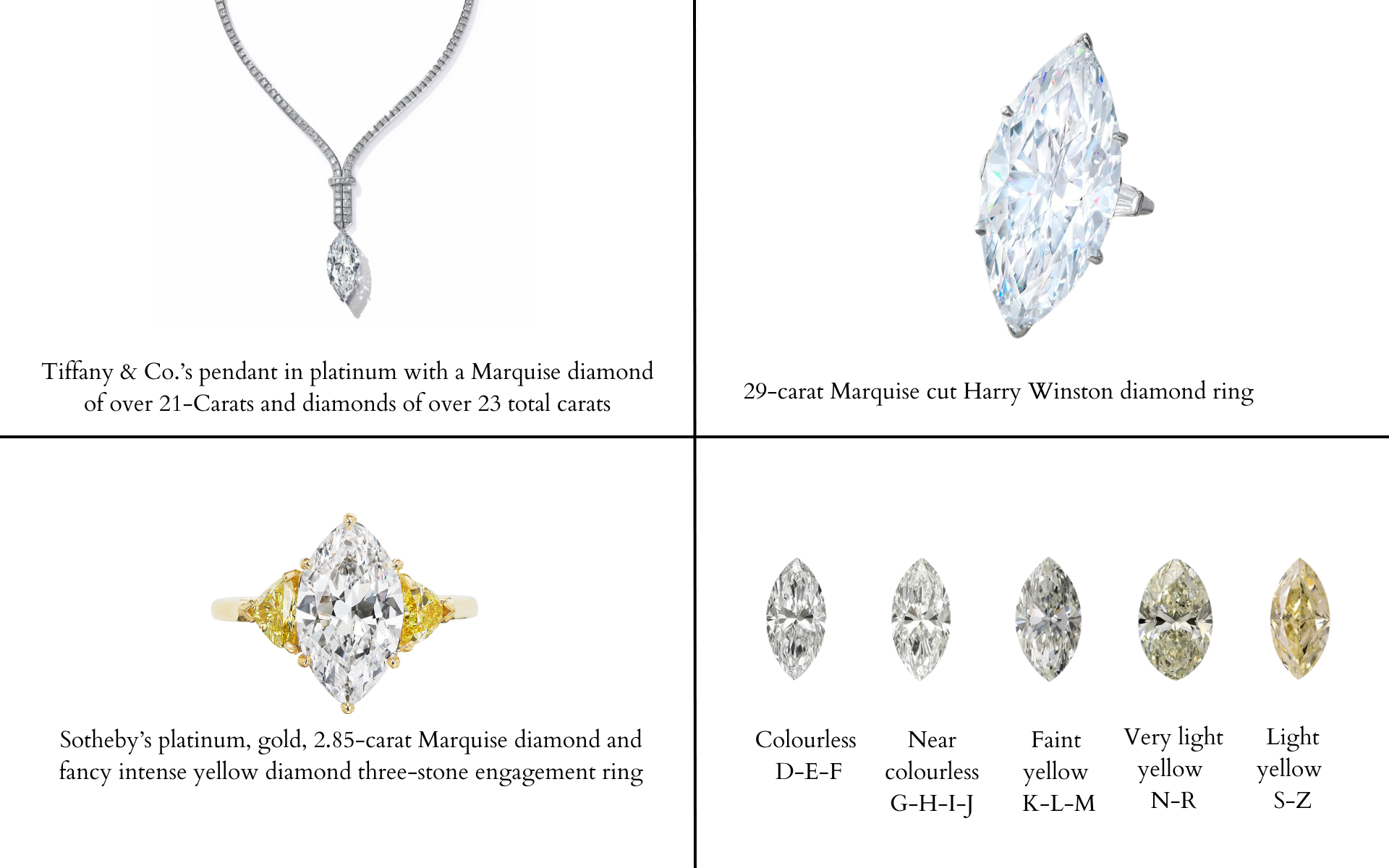
Images: Sotheby’s
There is something captivating about a Marquise diamond. Perhaps it is the way its elongated shape seems to stretch the light, resulting in a display that bridges the gap between contemporary and classic. Whenever we picture a Marquise diamond, its unique boat-like silhouette, inspired by the smile of the Marquise de Pompadour, gives away a sense of regalness. From the courts of French royalty to modern red carpets, this cut continues to be a perennial favourite. Here is your complete guide to a Marquise cut.
The Royal Origin of the Marquise Diamond Cut
The Marquise cut was inspired by the smile of a lady with origins deeply rooted in the palatial French Royal Court. Louis XV, the beloved King of France from 1715 to 1774, enjoyed a privileged youth. Fondly called Louis the Beloved by the court and his people, he sought to capture the beauty of his mistress’s smile in a diamond.
The story began in Versailles, where the king encountered a woman named Jeanne Antoinette Poisson. Struck by her beauty and declaring her lips to be the “most perfect” he had ever seen, he made her his chief mistress, bestowing upon her the title of Marquise de Pompadour. Wanting to immortalise her beauty, the king commanded his royal jeweller to craft a diamond that mirrored the mistress’ lips. The jeweller then went on to shape the stone into an elongated form, creating what we now recognise as the Marquise cut.

Images: Châteux De Versailles and Smithsonian Magazine
Stealing the Spotlight
In the grand halls of 18th and 19th-century Europe, among the nobility and aristocrats, this new diamond cut began to make waves and quickly became a symbol of status. Its boat-like form earned it the name “navette”, meaning “little boat” in French.
Over the years, the spell of the Marquise cut only grew. By the 1920s and 1930s, the world was swept up in the bold, geometric designs of the Art Deco Movement. Engagement rings and fine jewellery featuring Marquise diamonds became highy sought after during this time and the cut experienced a revival in popularity.
The Craft and Grading
The Marquise cut, known for its brilliance, has a design similar to the Round Brilliant cut, with 57 facets arranged in triangular and kite shapes—33 on the crown and 24 on the pavilion. Unlike the Round Brilliant, the pavilion of a Marquise can have 4, 6, or 8 main facets, adding to its appeal.
The classic length-to-width ratio for a Marquise cut diamond is 2:1, meaning the stone is twice as long as it is wide. However, there’s flexibility within this range and a ratio between 1.80 and 2.10 can result in a proportioned diamond.

Image: Quality Diamonds
The Four Cs of Marquise Diamonds

- Carat Weight
When choosing a Marquise diamond, carat weight plays an important role. It measures the diamond’s size and often correlates with its value. For Marquise diamonds, this factor influences the stone’s appearance. Because it has a larger surface area compared to other cuts, even a diamond with a lower carat weight can look impressively large.
- Clarity
Clarity is all about the presence or absence of tiny internal and external imperfections, known as inclusions and blemishes. Just like any other diamond, Marquise diamonds go through a grading process to determine their clarity grade. It is held under the light and checked for such blemishes. Because of its elongated shape, this diamond can sometimes have elongated inclusions, called “bowtie” effects, but these don’t necessarily mean the diamond is of lower quality.
- Color Grades
When selecting a Marquise diamond, remember that its shape and cut can influence how its colour is perceived. The shape of the cut can, at times, enhance their colour, meaning that even diamonds with a lower colour grade can still look stunningly white to the naked eye. This is one of the unique charms of the cut.
If you prefer a diamond that appears more colourless, you might lean towards a higher colour grade. But if you enjoy a warmer hue, a slightly lower colour grade could be the one for you. It’s all about finding what feels right to you.
- Cut Quality
Examining the cut quality of a Marquise diamond is like checking the harmony of a piece of music. You want the points of the diamond to align perfectly, creating a balanced and symmetrical shape displaying an evenly distributed “bowtie effect”.
Conversely, if the diamond is poorly cut it can be like a song out of tune–its sparkle may fall flat. Misaligned points and uneven proportions can dull its shine and affect how it reflects light. So, take your time in analysing the diamond’s symmetry.
The Ideal Setting for Marquise Diamonds
Selecting the right setting for your Marquise diamond can elevate its appeal while keeping it safe, much like choosing the perfect frame for a work of art. A prong setting, for example, is a favorite for this cut. The prongs allow plenty of light to enter while carefully positioned to safeguard the diamond’s delicate pointed ends. For a modern touch, consider bezel or tension settings that provide a sleek look along with protection.
Famous Marquise Jewels and The Stories Behind Them
One of the most famous Marquise diamond rings was given to Jackie Kennedy Onassis, first lady of the United States from 1961-1963, by her second husband Aristotle Onassis in 1968. This gem, known as Lesotho III, started as a 601-carat rough diamond named Lesotho, discovered in 1967 in South Africa. The rough diamond was acquired by jeweller Harry Winston, who cut it into 18 gems.
Before its transformation, the Lesotho diamond was displayed at the Smithsonian Institution in Washington, D.C. and the Musuem of Natural History in New York. Among the resulting gems, the Lesotho III was the Marquise diamond with VS2 clarity, L colour and 40.42 carats. In 1996, this piece was auctioned by Sotheby’s as part of Jackie Kennedy Onassis’ estate, selling for INR 21.68 crore ($2.59 million).
Apart from Jackie Kennedy Onassis, other celebrities dazzled the world with a Marquise diamond ring. In 1998, David Beckham proposed to Victoria Beckham with a 3-carat Marquise diamond set on a yellow gold band. The following year, Michael Douglas chose a 10-carat Marquise diamond ring, surrounded by a halo of 28 diamonds, to propose to Catherine Zeta-Jones and in 2008, Ellen DeGeneres presented Portia de Rossi with a 3-carat Marquise diamond ring.
From its royal origins to its resurgence in the Art Deco era, the Marquise cut has always stood for its charm. When selecting your Marquise diamond, keep in mind the importance of the four Cs, the perfect setting and the unique appeal of this cut. Whether you are drawn to its regal heritage or its contemporary sparkle, a Marquise diamond ring is sure to be a treasured heirloom.
Discover more stories on luxury, business, culture, and innovation here at Candle Magazine
